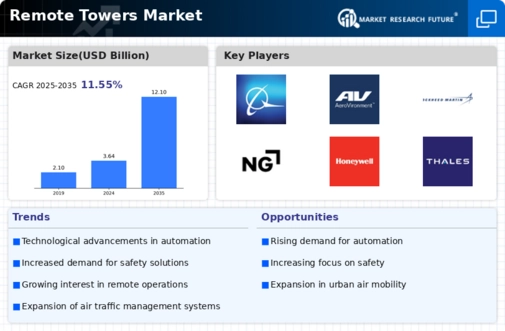Top Industry Leaders in the Remote Towers Market

The competitive landscape of the Remote Towers market is integral to the air traffic management industry, revolutionizing the way air traffic control services are delivered. Key players in this market deploy various strategies to navigate challenges and capitalize on the increasing demand for remote tower solutions that enhance operational efficiency and reduce costs.
Key Players:
Saab AB (Sweden)
Frequentis Group (Austria)
Thales Group (France)
Indra Sistemas, S.A. (Spain)
Raytheon Technologies Corporation (US)
L3Harris Technologies, Inc. (US)
Northrop Grumman Corporation (US)
Lockheed Martin Corporation (US)
Searidge Technologies (Canada)
Leonardo S.p.A. (Italy)
Strategies Adopted:
The Remote Towers market deploy strategic initiatives to address the evolving needs of ANSPs, airport operators, and aviation authorities. Notable strategies include continuous investment in research and development, diversification of remote tower product portfolios, strategic partnerships, and a focus on meeting emerging market demands. Frequentis AG, for instance, emphasizes R&D investments to enhance remote tower functionalities, showcasing a commitment to technological advancement. Strategic collaborations between Saab AB and ANSPs aim to optimize remote tower implementations for specific airport configurations, demonstrating a cooperative approach to addressing the diverse needs of the air traffic management industry.
Market Share Analysis:
The Remote Towers market is influenced by factors such as the performance and reliability of remote tower systems, adaptability to different airport sizes, pricing competitiveness, and the ability to provide comprehensive solutions for various air traffic management scenarios. Companies excelling in delivering high-quality, technologically advanced remote tower systems, ensuring compliance with stringent aviation standards, and offering flexibility to meet the specific requirements of different airports are strategically positioned to capture a larger market share. Establishing strong relationships with ANSPs, participating in pilot programs, and understanding the regulatory landscape of remote tower implementations are crucial for maintaining a competitive edge in this sector.
News & Emerging Companies:
The Remote Towers market has seen the emergence of new companies aiming to address the growing demand for innovative and cost-effective remote tower solutions. Emerging entrants, such as Searidge Technologies and Remote Control Technologies, have gained attention for their focus on introducing advanced remote tower technologies that cater to the needs of both large and small airports. These emerging companies contribute to the market by introducing fresh perspectives and agile approaches to address the evolving needs of air traffic management, particularly in the context of the growing adoption of remote tower solutions.
Industry Trends:
The Remote Towers market underscores ongoing investment trends, with a strong emphasis on enhancing remote tower capabilities, expanding the use of artificial intelligence (AI), and addressing cybersecurity concerns. Companies are investing significantly in the development of remote tower technologies with increased functionalities, including advanced surveillance and communication features. The integration of AI into remote tower systems is a focus to enhance the automation of air traffic control processes, improving efficiency and reducing the workload on controllers. Investments in addressing cybersecurity concerns reflect the industry's response to the growing importance of securing remote tower infrastructure against potential threats.
Competitive Scenario:
The Remote Towers market is marked by intense competition among established players and the entry of innovative newcomers. With air traffic management seeking more efficient and cost-effective solutions, companies aim to differentiate themselves by offering comprehensive remote tower solutions that address the challenges of modern aviation. Established players focus on refining their remote tower designs, expanding their market presence through strategic collaborations with ANSPs and airport operators, and staying informed about emerging technologies and regulatory requirements. The entry of emerging companies adds dynamism to the market, fostering an environment of continuous improvement and responsiveness to the changing demands of the air traffic management industry.
Recent Development
The Remote Towers market witnessed a significant development as Indra Sistemas announced the successful deployment of its remote tower solution at a major international airport. The deployment showcased the remote tower system's enhanced capabilities, including real-time surveillance, integrated communication features, and advanced automation functionalities. This development highlights Indra Sistemas' commitment to advancing remote tower technologies and reinforces its position as a key player in the market. The successful deployment is expected to contribute to the overall improvement of air traffic management capabilities, offering increased flexibility and efficiency for airport operations. The announcement reflects the industry's continuous efforts to evolve and provide cutting-edge solutions that address the challenges posed by the dynamic air traffic management landscape, emphasizing the importance of advanced remote tower technologies in ensuring the safety and efficiency of air traffic operations.


